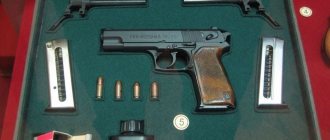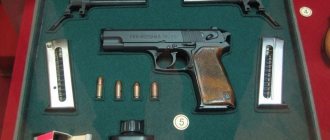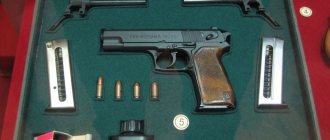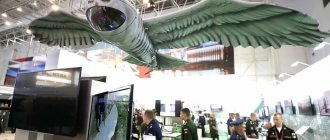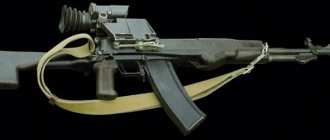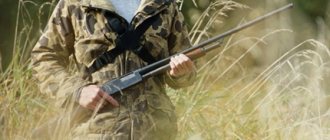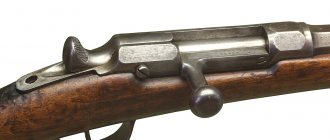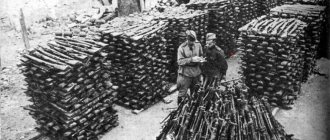The first captured MaschinenKarabiner 42: who captured the new weapon and when?
When a weapon reaches the front, it can be captured by the enemy. This is always unpleasant and they try to avoid such a turn of events. Therefore, it is interesting: who and when captured the first German MaschinenKarabiner 42?
Some Russian sources claim that the first MkBs were captured back in March 1943. However, this information has not yet been confirmed by any documentary data.
According to the author's archival research, the chronology of the capture of the first MaschinenKarabiner 42 is as follows.
In the TsAMO RF file, fund 81 file 87 (correspondence on foreign small arms), there is a report dated June 1943:
“To the Head of the GAU KA. I am sending with a special technician, Lieutenant N.N. Troitsky. a German automatic carbine and four cartridges for it, captured in June at the 22nd Army site in the area of the city of Kholm.”
MKb42(H) with serial number 1334 then ended up at the Soviet rifle test range with three rounds. Probably one cartridge was immediately sent to ammunition specialists. This MKb42(H) underwent preliminary research in July 1943.
MKb42(H)
Due to a shortage of original German cartridges, the test site was asked to independently make 500 pieces “by recompressing German cartridges and cutting bullets” for further testing.
Dieter Handrich's book Sturmgewehr 44 states that in April 1943 an order was issued to conduct military tests of Mkb-42(h) assault rifles. As a result, about two thousand pieces were sent to GA “North”; They were intended for the following divisions: 1st, 11th, 21st, 93rd, 212th infantry divisions (Infanterie-Division) and 18th Panzergrenadier-Division.
In fact, the list was slightly different, but for us the most interesting thing is that the 213 MaschinenKarabiner was received by the 93rd Infantry Division (93. Infanterie-Division), which lost seven already in June 1943 (NARA T-315 R-1167 and T-312 R -600).
It was the 93rd Infantry Division that was located in the area of the city of Kholm and was the enemy of the Soviet 22nd Army. The front line in this area was relatively stable. Obviously, it was precisely this consideration that served as the reason for sending a batch of new weapons here for testing in combat conditions. However, the German command did not take into account the high activity of Soviet military intelligence in this area.
German soldier with Mkb.42(H). Source: waralbum.ru
In the June combat log of the 22nd Army, the first entry for the month records the army commander’s decision: “Conduct reconnaissance in order to capture control prisoners and clarify the enemy grouping.” And in the future, a significant part of the reports is devoted to intelligence actions.
So, on the first of June, scouts from the 15th Motorized Rifle Brigade successfully went for a tongue, dragging a German from the 12th Infantry Division, and on the front sector of the 46th Motorized Rifle Brigade, a German reconnaissance group “trampled” in a minefield, losing one soldier. The next day, the brigade's scouts went to the Germans for a return visit, throwing grenades at the bunker. On the third, both sides were unlucky - German reconnaissance stumbled upon the combat outpost of the 11th Guards Motorized Rifle Brigade, and the Germans spotted scouts of the 82nd rifle regiment 30 meters from their trenches.
Other reconnaissance groups operated in the German rear, and thanks to their reports, the usually dry and “clerical” document reads almost like the story “Star”: evading pursuit, language grabs, radio operator tips...
On June 6, one of the captured prisoners from the 93rd Infantry Division spoke during interrogation about the presence in their company of “up to 10 carbine-machine guns of the 1942 model,” but the Soviet soldiers managed to get to know them better a few weeks later.
On June 22, 1943, a group of reconnaissance officers from the 820th Infantry Regiment under the command of Junior Lieutenant Arkhipov and a platoon of Lieutenant Ivushkin surrounded and attacked a German reconnaissance group that was in ambush. Soviet documents indicate that it was a platoon of the 1st Battalion, 273rd Regiment, 93rd Infantry Division. But there was a typo in the first report: in fact, it was about one of the grenadier regiments of the 272nd division. During the battle, 12 German soldiers were killed, three (two chief corporals and one private) were captured.
Among the trophies captured by Soviet intelligence officers, “four machine guns-carbines” are listed.
Soviet soldiers with a German trophy
During subsequent interrogation, German intelligence officer Hugo Hinsche reported that in mid-May 1943, a battalion reconnaissance platoon consisting of 27 people was formed in the 1st battalion of the 272nd Grenadier Regiment. The platoon was armed with carbine-machine guns of the 1942 model.
It can be said with high probability that it was the scouts of the Soviet 820th Infantry Regiment who became the first Allied soldiers to capture a new type of German small arms.
The history of the 1943 model cartridge, Kalashnikov assault rifles and everything else begins with these people.
Did you like the article? Fighting Cats need ammo - support us on Patreon! ^_^
History[edit]
As early as 1918, the German Army began to study the possibility of creating an intermediate cartridge and rifle. [3] However, a combination of military orthodoxy, limited funds, and restrictions on weapons development under the Treaty of Versailles led to Germany's adoption of the Mauser Karabiner 98K on June 21, 1935. conditions and tactical directions for developing new tactics and equipment requirements. [1] One of the repeated lessons was the existing size of 7.92x57 mm. The rifle cartridge turned out to be more powerful and longer-range than required. Since most of the combat took place at ranges less than 400 m (440 yd), a less powerful round could be used, which would mean the soldier could carry more ammunition, the weapon could be shorter, lighter, and with less recoil the weapon could be automatic. . [1] Submachine guns had existed since World War I, but they used pistol-caliber ammunition and lacked the range and accuracy required by the German army. A new intermediate cartridge was needed, and the 7.92×33mm Kurz was developed in response to this requirement. The specification called for a new weapon that was larger than a submachine gun, more accurate, longer-ranged, and more maneuverable than a full-size rifle.
Contracts for weapons firing the 7.92×33mm Kurz cartridge were issued to both Haenel and Walther, who were asked to submit a prototype weapon called the Machinenkarabiner 1942. [2] The (H) and (W) in their names refer to the first initial meaning. each gun manufacturer Haenel and Walther to differentiate them. In December 1940, a prototype rifle from Haenel and Walther was tested by the HWA in Kummersdorf. It had several jams, several barrels bulged, and one had a catastrophic failure. Testers blamed the results on poor quality ammunition. In February 1942, 10 million rounds of 7.92 mm ammunition were ordered for field testing. On July 9, 1942, field and comparative tests of ammunition and the Haenel MKb 42 (H) rifle were carried out. 3,654 shots were fired; 11 cases were examined, 67 shells were found to be unexploded (56 fired in the second test), and many more shells jammed. The reason for the failures was the stage of creating a prototype of the weapon. [4]
Description
The machine uses a gas exhaust system, in which part of the powder gases that push the bullets is diverted from the barrel through two holes into a special casing. These gases press down on an annular gas piston that is placed around the barrel and bushing to propel the bolt, unlike previous Walther designs that used a piston for this purpose. The barrel bore is locked by turning the bolt, in the front of which there are lugs.
The flag translator for firing modes is located on both sides of the receiver. The sighting device is mounted on a high base due to the use of a “linear” design (the butt and moving parts of the automatic are on the same axis with the barrel) and consists of a front sight with a front sight and a sector sight.
Wooden stock. Stamping was widely used in the manufacture of the machine gun.
Excerpt characterizing MKb.42(W)
He shook her hand. – Didn’t you sleep? “No, I didn’t sleep,” said Princess Marya, shaking her head negatively. Unwittingly obeying her father, she now, just as he spoke, tried to speak more with signs and seemed to also be moving her tongue with difficulty. - Darling... - or - friend... - Princess Marya could not make out; but, probably, from the expression of his gaze, a gentle, caressing word was said, which he never said. - Why didn’t you come? “And I wished, wished for his death! - thought Princess Marya. He paused. “Thank you... daughter, friend... for everything, for everything... forgive... thank you... forgive... thank you!..” And tears flowed from his eyes. “Call Andryusha,” he suddenly said, and something childishly timid and distrustful was expressed in his face at this demand. It was as if he himself knew that his demand made no sense. So, at least, it seemed to Princess Marya. “I received a letter from him,” answered Princess Marya. He looked at her with surprise and timidity. - Where is he? - He is in the army, mon pere, in Smolensk. He was silent for a long time, closing his eyes; then in the affirmative, as if in response to his doubts and to confirm that he now understood and remembered everything, he nodded his head and opened his eyes. “Yes,” he said clearly and quietly. - Russia is dead! Ruined! - And he began to sob again, and tears flowed from his eyes. Princess Marya could no longer hold on and cried too, looking at his face. He closed his eyes again. His sobs stopped. He made a sign with his hand to his eyes; and Tikhon, understanding him, wiped away his tears. Then he opened his eyes and said something that no one could understand for a long time, and finally only Tikhon understood and conveyed it. Princess Marya looked for the meaning of his words in the mood in which he spoke a minute before. She thought that he was talking about Russia, then about Prince Andrei, then about her, about his grandson, then about his death. And because of this she could not guess his words. “Put on your white dress, I love it,” he said. Realizing these words, Princess Marya began to sob even louder, and the doctor, taking her by the arm, led her out of the room onto the terrace, persuading her to calm down and make preparations for departure. After Princess Marya left the prince, he again started talking about his son, about the war, about the sovereign, twitched his eyebrows angrily, began to raise a hoarse voice, and the second and final blow came to him. Princess Marya stopped on the terrace. The day had cleared up, it was sunny and hot. She could not understand anything, think about anything and feel anything except her passionate love for her father, a love that, it seemed to her, she did not know until that moment. She ran out into the garden and, sobbing, ran down to the pond along the young linden paths planted by Prince Andrei.
Links
Rifles, carbines, machine guns Gewehr 1888 • Mauser 98 • Mauser 98k • Walther SK-39 • Gewehr 41 • FG-42 • MKb.42(W) • M30 Luftwaffe • SDK • Grossfuss Sturmgewehr • Gewehr 43/Karabiner 43 • HIW VSK • StG-44 • StG45 (M) • Knorr-Bremse • VK-98 • Volkssturmgewehr 1-5 • Wimmersperg Spz • Erma Volkssturmgewehr • Vollmer M-35 • Volkssturm-Mehrladegewehr Submachine guns MP-18/MP-28 • MP-34 • MP-35 • MP-36III • MP-38/40/41 • EMP-35 • MP3008 “Volks MP” Machine guns MG 08 • MG-08/15 • MG 13 • MG 34 • MG 39 Rh • MG 42 • MG 45 • VMG 1927 • Barnitzke • BSW Modell 1 • MG-81 • FWA Hobart Anti-tank weapons Grenade launchers Faustpatrone • Panzerfaust • Panzerschreck • 8.8 cm Raketenwerfer 43 “Pupchen” • Schiessbecher • Kampfpistole Anti-aircraft grenade launchers Fliegerfaust • Luftfaust-A • Luftfaust-B Mortars Granatwerfer 36 • 8-cm sGW34 • KZ 8 cm GrW 42 • 10 cm Nebelwerfer 35 • Granatwerfer 42 Flamethrowers Flammenwerfer 35 • Abwehrflammenwerfer 42 • Einstossflammenwerfer 46 Foreign weapons Rifles Vz.24/G24(t) • Gewehr 242(f) • Gewehr 306/Karabiner 561(g) • Gewehr 98(ö)/Gewehr 306/Karabiner 505(i) • Gewehr 249(a) • Winchester Model 1895 • Gewehr 301(f) • Selbstladekarabiner 455(a) • G289(j) • Gewehr 241(f) Submachine guns MP.34(ö) • MP.722(f) • MP.746(d) • MP.716(r) • MP.715(r) • MP.717(r) • MP.41(r) • MP .719(r) • MP.739(i) • MP.738(i) • MP.761(f) • MP.769 • SS-42 Machine guns MG26(t) • MG 07/12(ö) • MG30(t) • MG 099(i) • MG-126(b)/MG-147(j)/MG-156(f) • MG 157(f) • schwere MG 200(i) • MG 216(r) • 7.7mm sMG 230(e) • MG.105(f)/MG.201(n)/MG.257(f)/MG.257(p) • leicht MG 28(p) • MG35/36A Anti-tank rifles Solothurn S18-100 • Panzerbüchse 35(p) • PzB M.SS.41 Hand grenades Stielhandgranate • Eihandgranate • HL-Handgranate • Volkshandgranate • Panzerwurfmine • Nipolit • Glasgranate • Hafthohlladung Ammo 7.65x17mm • 7.63x25mm Mauser • 7.92x33mm • 7.65x21mm Parabellum • 7.92x57mm • 9x19mm Parabellum
